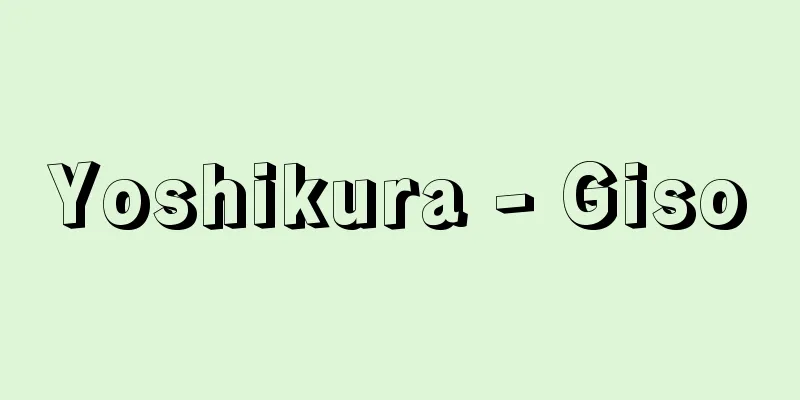Yoshikura - Giso

|
In China, a storage warehouse for providing food and seeds to farmers in the event of poor harvests. It was also called a sha-gō. In 585 during the Sui dynasty, it was established in a shrine consisting of 25 households, and under the management of a shrine official, farmers were required to pay millet according to their wealth, but this practice weakened toward the end of the Sui dynasty. The early Tang dynasty tried to follow this example, and in 628, they again collected two sho of millet or non-glutinous rice per mu (about 544 square meters), while merchants without rice fields were also required to provide their share of millet. Later, as it gradually became a tax, it was placed in prefectures and counties and was managed by government officials, and was misappropriated when there was a financial shortage, and was devastated especially during the An Lushan Rebellion. However, an attempt was made to revive it during the reign of Emperor Xianzong (reigned 805-820). In the Song dynasty, the two tax laws imposed a tax rate of 1 to per koku, and in times of poor harvests, seeds and food were provided, and loans were also made. However, as commercial cities developed, more prefectures, counties, and towns were located near the cities, and it was permitted to store them in county storehouses, so there were fewer in rural areas, making it inconvenient for farmers to use. Therefore, rather than fulfilling their original function, more were located near cities or for lending to city residents, and the Northern Song dynasty repeatedly established and abolished them. The Liao and Yuan dynasties also established them, but only in name; the Jin dynasty did not establish them, and the Ming dynasty only had social storehouses. The Qing dynasty established them from the early days, and had them run by elected influential people and merchants, and relied on private donations and other sources, but they weakened during the Taiping Rebellion, and attempts were made to revive them but to no avail. [Tadao Aoyama] In Japan, under the ritsuryo system, households were divided into nine classes according to wealth, and each class was required to pay a certain amount of millet (rice, wheat, or beans were also acceptable) and keep it. It was originally intended to store food in preparation for poor harvests and to provide it to the poor as needed, but in reality it became an additional tax levied annually. However, in the Nara period, there were only a few wealthy people who should have been the core of taxpayers in rural areas, and the majority were made up of poor people who were the target of poverty relief. For example, according to the surviving 750 (Tenpyo Shoho 2) Gisokura register for Awa Province (Chiba Prefecture), about 80% of the total were not even classified as class 9. As a result, the income and expenditure of the Gisokura were always in a large deficit, and it was finally abolished in the Heian period. This system was adopted again in the Edo period as a reserve for the shogunate and various feudal domains, and it was revived as one of the three kura, along with the Shakura and Tsunehirakura. [Hirata Koji] [Reference item] |Source: Shogakukan Encyclopedia Nipponica About Encyclopedia Nipponica Information | Legend |
|
中国で凶作の際、農民に食料と種子を支給するための貯蔵倉。社倉ともよばれた。隋(ずい)代の585年、25戸よりなる社に設けられ、社司(村役人)の管理のもとに、貧富の程度によって粟麦(ぞくばく)を納めさせたが、隋末に弛廃(しはい)した。唐初はこれに倣おうとし、628年、改めて1畝(ほ)(約544平方メートル)当り粟麦または粳稲(こうとう)(うるち)2升を徴する一方、田のない商人からも多くは応分の粟を出させた。のち、しだいに税化するにつれて州県に置かれて官吏がつかさどるようになり、財政不足のおりに流用され、ことに安史の乱に荒廃した。しかし憲宗(在位805~820)のとき復活が試みられた。宋(そう)代には両税法により税額1石につき1斗を課し、凶作のとき、種、食を給し、ついで貸付けも行った。しかし、商業都市が発達するにつれて、州・県・鎮など都市の近くのものが多くなり、県倉に納めることも許されたので、農村にはかえって少なくなり、農民の利用に不便となった。したがって義倉本来の機能よりは、都市近傍のもの、または都市民への貸付けが多くなり、北宋には置廃を繰り返した。遼(りょう)や元(げん)もこれを置いたが名のみで、金(きん)は置かず、明(みん)は社倉のみであった。清(しん)は初期から置き、公選の有力者や商人に運営させ、民間の寄付その他によったが、太平天国の乱に弛廃し、復活が試みられたが実効はあがらなかった。 [青山定雄] 日本では令制(りょうせい)下の各戸を貧富の差によって9等に分け、その等級に応じて一定額の粟(稲・麦・豆でもよい)を納めさせ、保管運用する制度。本来は凶作に備えて食糧を貯蓄し、必要に応じて困窮者に給付するものであったが、実際には毎年賦課される付加税となった。しかし奈良時代の農村で納税者の中核となるべき富裕者はごく少数で、大多数は救貧の対象となる貧窮者によって成り立っており、たとえば、現存する750年(天平勝宝2)の安房(あわ)国(千葉県)義倉帳によると、9等の基準にすら該当しない等外戸が全体の約80%を占めるごとくで、そのため、義倉の収支はつねに大幅な赤字とならざるをえず、平安時代になるとついに廃絶した。この制度は、江戸時代になってふたたび幕府や諸藩の備荒貯蓄として採用され、社倉・常平倉とともに三倉の一として復活した。 [平田耿二] [参照項目] |出典 小学館 日本大百科全書(ニッポニカ)日本大百科全書(ニッポニカ)について 情報 | 凡例 |
<<: Equipment - Giso (English spelling) equipment
Recommend
Aztec
A nation that flourished from the 14th century unt...
Autostrada - Autostrada
...Also, the Shuto Expressway and the Hanshin Exp...
Beauty - Beauty
It means to make one's appearance beautiful. ...
Khokand Khan Country - Khokand Khan Country
An Uzbek state centered in Khoqand in Central Asia...
Amayo no Mikoto - Amayo no Mikoto
The ancestral deity of the blind who appears in th...
Director - Enshutsuka
〘 noun 〙 A person who specializes in the work of d...
'Ali b. Rabban al-Ṭabarī (English spelling) Ali b Rabban al Tabari
... Based on the above-mentioned translation peri...
Far Eastern Commission
This was the policy-making body for the Allied Po...
marmalade
...Fruits used include strawberries, currants, ra...
Deductive reasoning
...The mechanism that manipulates such knowledge ...
Nakajima [town] - Nakajima
An old town in Onsen County, northwest of Ehime Pr...
Shanxi Merchants
Merchants and financiers from Shanxi and Shaanxi ...
Vasil'evskii, Ostrov (English spelling)
...After that, pontoon bridges and pontoon bridge...
job description
… The information items obtained are: (1) the cre...
Bamboo sword - No
A type of imitation sword invented for the traini...









